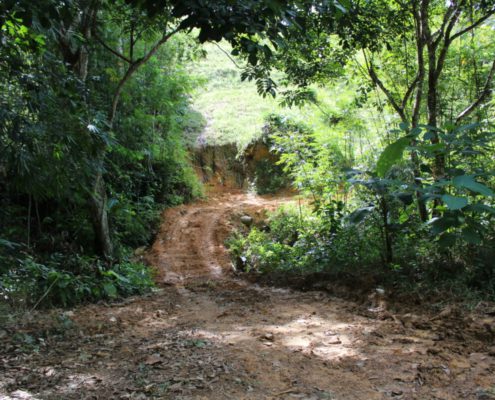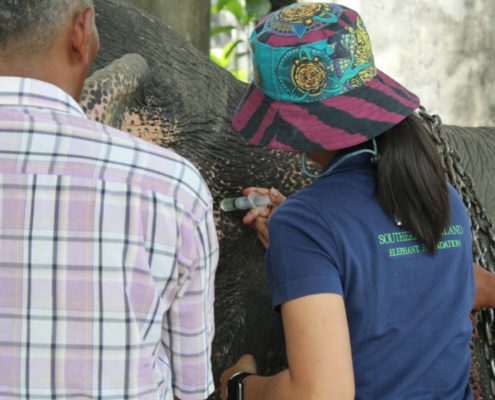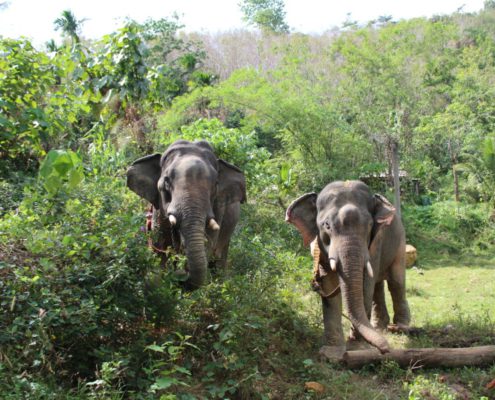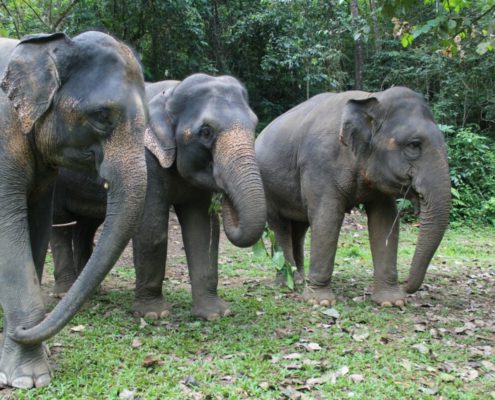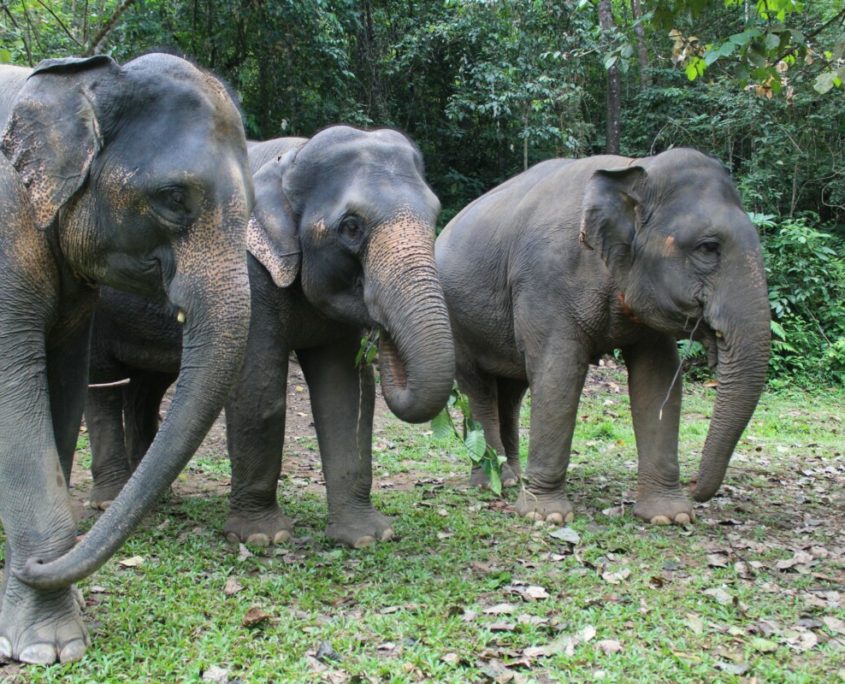My 6 Weeks as an Elephant Vet – Week Four
A blog by veterinary volunteer Vanessa Klabouch, a vet student at TiHo Hannover
23.01.23
This morning we left for the province of Trang which was a 5 hour journey. There was plenty to see, and I’ve never been that far south in Thailand. We first met one of the mahouts at his house for lunch, and his wife cooked up a feast. We were warmly welcomed and, on top of that, invited to stay for the night. He offered us his tree house, all wooden, beautiful, and big enough for all of us, with an open bathroom.
But first work called. Nine logging elephant patients were scheduled for today and, as previously mentioned, they are always found somewhere in the jungle due to the forest work. We drove around on a remote adventure again, and whenever we got into a hairy moment “into the unknown” (for those not familiar: frozen) came to our mind and we trilled the chorus nicely while the car fought its way through the mud. At one point we had to abandon ship, our four-wheel drive made it, but not the second car. Den, Dr Aon and the mahout drove on, and a local said it was only 300m so we started walking… After a good kilometre the others came towards us laughing, the elephant had already been treated and it was more like a 2km hike. But anyway, we had a nice walk!
All the elephants today were in generally good condition, and standard medication like deworming, broad spectrum antiparasitic and supplements were administered.
24.01.23
The next morning we had to get up early again. We went further south into the provinces, this time to check up on 13 elephants, all of course nicely distributed within the unknown Southern Thailand wilderness. We didn’t really know where to go so we followed Den and the local mahout. We drove through clearings, along rivers and lakes, up the mountains and through gorges; it was fantastic.
Some of the elephants we saw had gadfly infestations and were therefore given Ivermectin, but the majority were in good condition. Being working elephants, they were generally very fit, muscular and still young. One animal had an edema under the chin, so we took blood from this one to clarify. There was another one with an abscess which did not affect him and therefore required no attention, and one with a swollen ankle who was given anti-inflammatory drugs and oil. The more elephants we examine, the more I start noticing the little things about them you could easily overlook; the number of patients every day brings a lot of practice.
Our last elephant was in musth, which is why we only looked at him from a distance.You could even see the dripping from the temporal gland. Musth is the sexually active period in an elephant bull, and during this time these gentle giants are less gentle. The drainage of the temporal gland and urine dribbling is a typical sign they are in musth and they can get aggressive easily due to the testosterone. Also their testosterone concentration can reach up to 100ng/ml in this time compared to its non musth rate of 5 ng/ml. Normally the androstenedione concentration is higher than testosterone, but this changes in times of musth, and the dihydrotestosterone also increases. You can detect these parameters in blood and the temporal gland excretions, which exceeds the blood parameters 4-10 times.
After this excitement, we made our way back to the Veterinary Centre . Six hours of travel lay between us and our well-deserved beds. We finally made it, and ended up in bed by midnight.
25.01.23
Luckily, we were able to sleep in after the exhausting last few days as we had only received one call. Bukee, a 33-year-old female elephant who, according to the mahout, is urinating intermittently and dribbling. Dr Ming (junior vet at STEFT) administered antibiotics and took a urine sample to the lab for testing. If the administered antibiotic does not work, another one will be given after a resistance test. But it sounded like a urinary tract infection.
There was, however, more to be treated on Bukee; a nail crack in one of her feet and a cloudy spot on both eyes. The cloudy spots could be from an old corneal injury. The eyes were rinsed and given eye drops, which the mahout will then continue to apply. The nail crack, on the other hand, had to wait because unfortunately Bukee wasn’t trained for this type of treatment, so she wouldn’t have stayed still for us, and there were also no devices to bring the foot into position for treatment. So, we explained to the mahout what he should do to prepare for our return, and we made our way home.
Back at the hospital, we got on straight away. We put the test strips into the sample, assessing a drop under the microscope, stain one and assess cells and also centrifuge and examine sediment and supernatant. Unfortunately, the evaluation had to wait because the generator failed again when it got dark. We would continue tomorrow morning when it’s light.
26.01.23
A lab day. First, the standard medication had to be replenished, i.e. vitamins and deworming counted and packed according to weight class. Then, all other medication had to be refilled for upcoming trips.
Then we moved to blood analysis, blood chemistry and blood smears, blood count, and examination for blood parasites such as Trypanosoma.
Yesterday’s urine sample was then examined further and we used dipstick analysis, smear and sediment examination to analyse it. The Urine test stripe showed a high pH (9) which is very alkaline. But a variety of pH has been reported in elephants before, as well as the tendency to alkaline. Alkaline urine is typical for bacterial infection, but all kind of herbivores tend to have more alkaline urine as well. Some crystals could be seen, bacteria, no red or white blood cells. Calcium carbonate crystals are small intersecting dumbbell shaped rods or radiant dumbbell shaped spheres.
In the dung samples which we examined directly with sedimentation and floatation techniques, Protozoa, worm larvae and eggs could be found. Gastrointestinal parasitic infections in elephants have the same negative effect on health as in other animals, and can cause serious disease and mortality. Unhygienic circumstances and small enclosures predispose gastrointestinal parasitic infection. Strongyle type egg, Strongyloides sp., Ancylostoma sp. and Anoplocephala sp. have been recorded in other studies.
We determined our samples as Strongyloides. By comparison, Strongyle ova have thin shelled and embryonated egg inside, and Strongyloides ova have a thin shelled ova and larva inside, which is what it looks like in our case.
Beware! In the picture, the round ones are plant particles, not eggs.
Strongyloides free-living (soil) stage 1 and 2 larvae (L1 and L2) have what is called a rhabditiform oesophagus, which can be seen using a microscope, and the parasitic L3 larva and adults have a filariform oesophagus that takes up ⅓ of the body length. In our specimen, the oesophagus length was not ⅓ of the body length, therefore it could be a Strongylus sp. instead – several genera have been reported in Asian elephants. Molecular tools are needed for species identification of these roundworm larvae.
Several genera have been reported in Asian elephants but molecular tools are needed for species identification. All the elephants we treat are regularly dewormed, but gastrointestinal parasites are still often seen in the elephants.
We took a look at an elephant louse again. You can find more information here
In the evening we went to a night market in Phuket. There was plenty to see and buy including clothes, souvenirs, food, … You could easily spend some hours there, which we did! We went to bed way too late but it was worth it.
27.01.23
Today we checked on 6 elephants in a trekking camp. Nothing in particular just general deworming supplements and that’s pretty much it.
On the way back we stopped at Thai Muang beach and temple. The entire temple was made out of wood and there were palm trees all around. It was right next to the ocean, which was just beautiful!
Back in the hospital there was office work waiting for us, blood values from the last few months had to be sorted and filed in order.
And after a delicious dinner we were done for today and ready for the weekend.
28.01.23
Today we went to Phang Nga Elephant Park again and observed the elephants. One of them sometimes shows stereotypical behaviour, the rest were happily roaming around without signs of that. Before he came to the park this cutie had been kept alone in a small enclosure in a hotel with only the tourists passing by as entertainment. He spent his youth there and kept himself busy with swaying, a stereotypical misbehaviour. At Phang Nga she didn’t show it while eating, playing, or on the walk through the forest but started when getting bored or excited. I have seen that in many different elephants in Thailand and other places at zoos and it was always similar.
Stereotypical behaviour is a movement which is repeated nearly without variation and doesn’t have a clear function or goal. In elephants, it mostly consists of swaying, rhythmic head movements, or repetitive pacing. The cause of stereotypic behaviour is not clear even though it’s often seen in elephants kept like this one had been. There are no comparable studies, but the existence of it is seen as an indicator of poor welfare in elephants.
Different intensities of this behaviour can be observed between individuals, as well as seasonal and daily variations in the individuals. The behaviour often stop while eating and feeding. so enriching the different ways in which the elephants get their food can keep them entertained and away from stereotypical behaviour for that time. Also, having things to play with, such as tires and ropes, can help. But even if an elephant is living in perfect conditions free roaming with others, it’s often not possible to get it completely out of a habit like this again.
We had another great day at Phang Nga Park and especially enjoyed the hike, where the elephants could get a little workout and in between choose all kinds of plants they wanted to eat. After feeding and watching them having some fun bathing, we took off.
We stopped at the beach for a dip, and back at our place spent the evening with tons of ice cream and a movie night for our last evening. It was a very exciting week with so many amazing moments, interesting research evenings and good conversations. It was hard to say goodbye the next morning.



